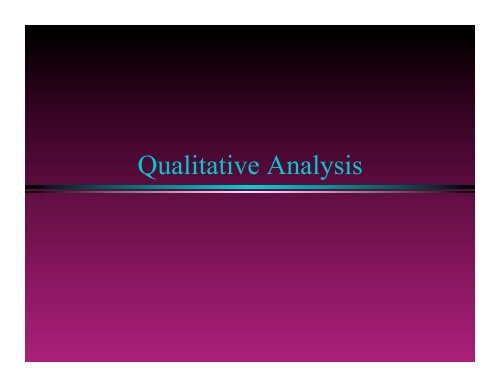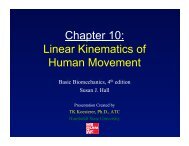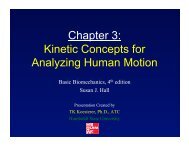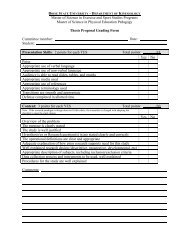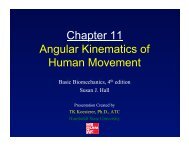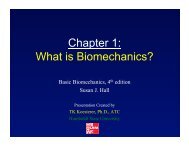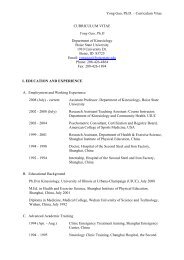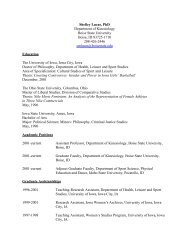Qualitative Analysis
Qualitative Analysis
Qualitative Analysis
You also want an ePaper? Increase the reach of your titles
YUMPU automatically turns print PDFs into web optimized ePapers that Google loves.
<strong>Qualitative</strong> <strong>Analysis</strong>
Steps in a <strong>Qualitative</strong> <strong>Analysis</strong><br />
Preparation<br />
Observation<br />
Evaluation and Diagnosis<br />
Intervention
Preparation<br />
the first task is to build a prerequisite<br />
knowledge base:<br />
knowledge about the activity or movement<br />
knowledge about the performer(s)<br />
knowledge about effective instruction<br />
knowledge about systematic observational<br />
strategy
Knowledge of the Activity<br />
Determine the overall performance<br />
objective, or goal of the movement.<br />
Need to know about the skills, strategy,<br />
and physical requirements of the<br />
activity.
Knowledge of the Activity<br />
Sources of information:<br />
Experience<br />
Expert opinion<br />
Scientific research
Experience<br />
Invaluable in any profession.<br />
Possible weakness is that it is often<br />
anecdotal and can be influenced by<br />
personal bias.
Expert Opinion<br />
Opinions of experts usually carry a lot of<br />
weight.<br />
Available sources are professional<br />
publications and professional meetings.<br />
Possible weakness is conflicting and<br />
changing opinions.
Expert Opinion<br />
Opinions are often influenced by the<br />
technique of a current champion, which may<br />
or may not be proper.<br />
Skilled performers often perform with little<br />
conscious thought about the process, and<br />
may not be the best source of information.
Scientific Research<br />
Provides the most valid and accurate<br />
information available for basing<br />
decisions about qualitative analysis.<br />
Unfortunately, practitioners often have<br />
difficulty understanding the research<br />
literature.
Knowledge of the Activity<br />
Professionals in human movement must<br />
weigh the evidence based on their own<br />
experience, expert opinion, and<br />
scientific research. The latter is<br />
probably the most valid because of its<br />
objectivity and experimental control.
Critical Features<br />
Key features of a movement that are<br />
necessary for optimal performance.<br />
based on the safety, effectiveness, and<br />
efficiency of the movement.<br />
their exact sequence or coordination is<br />
also very important.
Critical Features<br />
statements describing specific body<br />
movements that are observable.<br />
used to evaluate whether the key<br />
mechanical factors have been<br />
performed ideally.
Safety<br />
A professional must decide if a particular<br />
technique is safe for the performer.<br />
Considerations include:<br />
age of the performer<br />
level of conditioning<br />
injury status<br />
previous activity (readiness)
Range of Correctness<br />
Critical features should be defined as<br />
precisely as possible, but need to allow<br />
for variations inherent in performers.<br />
length/direction of stride in pitching<br />
angle of release of basketball free throw
Identifying Critical Features<br />
Identify the overall performance<br />
objective. Rank secondary objectives in<br />
order of importance.<br />
Divide the skill into discrete parts.<br />
Identify the mechanical purpose of each<br />
discrete part.
Identifying Critical Features<br />
List the biomechanical factors that<br />
determine the accomplishment of the<br />
mechanical purpose.<br />
Identify the biomechanical principles that<br />
relate to the biomechanical factors of the<br />
performance.
Identifying Critical Features<br />
List the critical features of each part<br />
that would contribute to the successful<br />
accomplishment of the mechanical<br />
purpose of that discrete part, and<br />
ultimately to the overall performance<br />
objective.
Knowledge of Performers<br />
Knowledge of the physical, cognitive,<br />
and emotional characteristics of<br />
performers is important in preparing for<br />
qualitative analysis.<br />
Performers have a wide variety of<br />
abilities based on genetics, age, gender,<br />
anthropometrics, experience, training,<br />
and skill-related fitness components.
Knowledge of Effective<br />
Instruction<br />
Prerequisite knowledge of pedagogical<br />
and motor learning research.<br />
An essential task is translating the<br />
critical features into teaching cues.<br />
The performer’s age, experience, and<br />
interest level may affect the choice of<br />
communication techniques.
Effective Presentation of<br />
Information<br />
Effective teachers provide a good<br />
demonstration of the skill, explicit verbal<br />
explanation, summary cues, direction of<br />
student attention to important factors<br />
(critical features), and a way to check<br />
for student understanding.
Knowledge of Systematic<br />
Observational Strategy<br />
phases of the movement<br />
appropriate vantage points<br />
visual limitations<br />
number of observations needed<br />
checklists or rating scales
Observation<br />
“You can observe a lot just by<br />
watchin’.”<br />
--- Yogi Berra
Systematic Observational<br />
Strategy<br />
A plan to gather all the relevant<br />
information about a human movement<br />
Involves two main decisions:<br />
what to observe<br />
how to observe it
Systematic Observational<br />
Strategy<br />
Critical features will be the targets of<br />
observation<br />
Sensory and information processing<br />
limitations must be considered.<br />
Our knowledge and expectations<br />
strongly influence what is observed.<br />
“We can only see in a picture what our<br />
experience permits us to see.” (Dale,<br />
1984)
Key Elements in a Systematic<br />
Observational Strategy<br />
which critical features to focus attention<br />
on<br />
how to control the situation<br />
vantage points of observation<br />
the number of observations needed<br />
whether extended observation will be<br />
needed
Focus of Observation<br />
Critical features - the focal points for<br />
observational strategy to follow<br />
Scanning strategy - planning focuses<br />
of attention<br />
what to look for<br />
when<br />
how long to look
Focus of Observation<br />
Environmental constraints<br />
rules of the sport<br />
psychological stress<br />
fatigue<br />
interactive nature of open skills
Focus of Observation<br />
Phases of the Movement<br />
preparation, execution, follow-through<br />
most common scanning strategy<br />
observe critical features in sequential order<br />
decreases risk of perceptual overload<br />
observe body component through the<br />
temporal (serial) phases of the movement
Focus of Observation<br />
Balance<br />
movement in many sports is strongly<br />
affected by variations in balance<br />
base of support and initial movements of<br />
the lower extremities often affect the<br />
actions of subsequent segments
Focus of Observation<br />
Importance<br />
observe the most important feature first.<br />
– observational strategy is based on a ranking of<br />
the relative importance of the critical features<br />
– some critical features may influence other<br />
aspects of the movement more than others
Focus of Observation<br />
General to Specific<br />
analyst considers all the parts of a<br />
movement and develops an overall<br />
impression of the quality of the movement.<br />
if the analyst feels there is something<br />
wrong, s/he can focus on the phases &/or<br />
body parts
Observational Situation<br />
The environment should be controlled<br />
as much as possible by the analyst, yet<br />
the task must be as realistic as<br />
possible.<br />
difficult, since qualitative analysis is most<br />
often performed in live competition<br />
easier with closed skills<br />
more difficult with open skills
Observational Situation<br />
Open skills - performed in an<br />
unpredictable, changing environment<br />
Closed skills - performed in a<br />
predictable environment; the performer<br />
is free to execute skill without making<br />
quick decisions and unexpected<br />
changes.
Observational Situation<br />
For open skills the analyst needs to<br />
plan observational situations that mimic<br />
the competitive environment.<br />
Even closed skills can be made more<br />
realistic with psychological pressure<br />
(basketball free throw).<br />
Remember the very fact that someone is<br />
watching can have an affect on<br />
performers.
Vantage Points<br />
Specify the optimal positions for<br />
observing a particular movement.<br />
Most common is at right angles to the<br />
plane of motion.<br />
Many movements will require several<br />
vantage points<br />
Most movement is three-dimensional
Vantage Points<br />
should have stable backgrounds without<br />
distractions or moving objects<br />
a uniform background of contrasting<br />
color is best<br />
horizontal &/or vertical references could<br />
be helpful in some cases (release angle)
Vantage Points<br />
The observer’s distance from the<br />
movement is determined by the nature<br />
and speed of the movement.<br />
the faster the movement, the greater the<br />
viewing distance<br />
space may limit the maximum distance<br />
closer vantage points are possible when<br />
observing slow, restricted movements
Number of Observations<br />
A compromise between gathering<br />
enough information for a good<br />
evaluation, and the time constraints of<br />
the situation.<br />
Number of trials affected by:<br />
performer’s consistency<br />
analyst’s experience<br />
complexity of the skill<br />
Rule of thumb is 5 to 8 trials
Extended Observation<br />
A plan for gathering more information<br />
than is usually observable.<br />
Utilized when a critical feature of interest<br />
is difficult to see.<br />
Extended observation includes:<br />
using video<br />
using multiple observers<br />
using multiple senses
Performer Involvement<br />
The performer’s observations can<br />
supplement the information collected by<br />
the analyst.<br />
Example: performer can provide<br />
feedback on how it felt (solid contact at<br />
sweet spot)<br />
Could help motivate performer to take<br />
ownership in the process and implement<br />
suggestions.
Evaluation & Diagnosis<br />
The Third Task<br />
of<br />
<strong>Qualitative</strong> <strong>Analysis</strong>
Evaluation & Diagnosis<br />
A critical evaluation of desirable and<br />
undesirable aspects of a performance<br />
and a diagnosis of the movement lead<br />
to a priority ranking of the corrective<br />
action the analyst will take.<br />
May be the most difficult task in<br />
qualitative analysis.
Evaluation & Diagnosis<br />
Evaluation - a judgment of the quality of<br />
the movement; the strengths and<br />
weaknesses of the performance.<br />
Diagnosis - critical scrutiny and<br />
judgment in differentiating a problem<br />
from its symptoms.
Evaluation may ask:<br />
Are the critical features of the movement<br />
within the desirable range?<br />
What are the strengths of the<br />
performance?<br />
What are the weaknesses or errors?
The Process of Evaluation<br />
To keep the task manageable, select no<br />
more than five to eight critical features.<br />
Specify as completely as possible the<br />
range of correctness of all critical<br />
features to be evaluated.
The Process of Evaluation<br />
Evaluate performance on each of the<br />
critical features using a simple rating<br />
scale, such as:<br />
inadequate<br />
within the desirable range<br />
excessive
Performance Variability<br />
When first learning a skill, performers<br />
exhibit a wide variety of errors.<br />
Analyst should view the movement<br />
several times (5-8).<br />
The error made in any one trial may be<br />
insignificant. Look for patterns.
Performance Variability<br />
Skilled performers are more consistent.<br />
Strengths and weaknesses are more<br />
subtle.<br />
However, also more consistent.
Hoffman’s (1983) diagnostic<br />
problem-solving approach
Ideal Form vs. Critical Features<br />
Critical features of any skill are dynamic<br />
and interact with a multitude of factors<br />
that affect performance.<br />
This interaction of critical features,<br />
performer traits, movement<br />
environment, and other factors makes it<br />
difficult to establish one ideal form for a<br />
particular movement.
Ideal Form vs. Critical Features<br />
Closed environment skills are likely to<br />
have a tighter range of correctness, and<br />
thus conform more closely to the<br />
concept of an ideal form.<br />
Open environment skills require greater<br />
flexibility, thus requiring the analyst to<br />
focus more on critical features and<br />
fundamental mechanical principles.
Summary<br />
<strong>Analysis</strong> involves judging the strengths<br />
and weaknesses of a person’s<br />
performance.<br />
Critical features should be evaluated<br />
only after an adequate systematic<br />
observation has been performed to<br />
gather relevant information.
Summary<br />
A few (5-8) critical features should be<br />
evaluated to one of three levels:<br />
inadequate<br />
within the desirable range<br />
excessive
Diagnosis<br />
Once we’ve identified errors (evaluation),<br />
how do we deal with them?<br />
The purpose of diagnosis is to narrow the<br />
strengths and weaknesses in the<br />
performance to focus on the single most<br />
important intervention.
Prioritizing Intervention<br />
Motor learning and psychology research<br />
suggests that most learners can focus<br />
on only one correction at a time during<br />
practice.<br />
Therefore, the analyst must prioritize<br />
intervention.
Prioritizing Intervention<br />
Little systematic research exists to validate a<br />
specific process for the diagnosis of<br />
performance.<br />
Difficult because the cause of a particular<br />
problem may be far removed from its<br />
observable effects (symptoms).<br />
A thorough understanding of biomechanical<br />
principles is the analyst’s best ally.
Prioritizing Intervention<br />
Six logical rationales have been<br />
proposed for prioritizing intervention:<br />
relationship to previous action<br />
maximizing improvement<br />
order of difficulty<br />
correct sequence<br />
base of support<br />
critical features first
Prioritizing Intervention<br />
Whichever approach is used to prioritize<br />
intervention, it is important to keep in mind the<br />
goal or purpose of the movement being<br />
analyzed; this will help shape priorities for<br />
corrections.<br />
The best rationale may be specific to the<br />
person or the motor skill.
Relationship to Previous Action<br />
Some errors are only symptoms<br />
because they are caused by another<br />
problem.<br />
A coach who focuses practice on errors<br />
symptomatic of another problem is<br />
wasting valuable practice time.
Relationship to Previous Action<br />
Not always easy to establish exactly what<br />
actions are related to what other actions.<br />
Ability to relate actions improves with<br />
increased knowledge of biomechanics and<br />
practical experience in qualitative analysis.
Maximizing Improvement<br />
Select intervention that can be expected to<br />
maximize improvement.<br />
Not always clear how to judge which<br />
correction leads to the most improvement.<br />
Initial improvement or long-range<br />
improvement?
In Order of Difficulty<br />
Make the easiest corrections first, if<br />
movement errors seem unrelated and of equal<br />
rank.<br />
Leads to performer’s perceived success,<br />
improvement, and thus greater motivation.<br />
No scientific evidence that this is most<br />
effective in improving performance.
Correct Sequence<br />
Provide intervention in the sequence of the<br />
actions in the motor skill.<br />
Little scientific evidence to support this<br />
domino theory.<br />
However, actions are sequential, and many<br />
errors are related to previous actions.
Base of Support<br />
For activities requiring balance or the<br />
control of large forces generated by the<br />
legs, focusing first on the base of<br />
support may be a logical strategy.
Critical Features First<br />
Improve critical features first, before<br />
other minor errors in performance.<br />
If the right critical features have been<br />
selected, they are obviously (by<br />
definition) most critical to the movement.<br />
Most movements have several critical<br />
features; how does one determine which<br />
are most important?
Summary<br />
Analysts must be deliberate in the evaluation<br />
and diagnosis of performance.<br />
Analyst must be absolutely sure of himself/<br />
herself before intervention with performer.<br />
Inappropriate feedback may frustrate the<br />
performer and damage the analyst’s<br />
credibility.
Intervention<br />
Strategies for Improving<br />
Performance
Intervention<br />
Intervention is the analyst’s<br />
administration of feedback, corrections,<br />
or other changes in the environment to<br />
improve performance.<br />
Has been given a variety of names:<br />
feedback<br />
remediation<br />
instructions to performers
Intervention<br />
More comprehensive than just feedback,<br />
instruction and/or error correction:<br />
positive reinforcement<br />
modeling<br />
physical guidance<br />
modify practice<br />
prescribe training<br />
adjusting equipment
Feedback<br />
The predominant mode of intervention is<br />
verbal feedback.<br />
Intrinsic feedback - information about<br />
the outcome.<br />
Extrinsic feedback - comes from an<br />
external source after the movement has<br />
been completed.
Functions of Feedback<br />
Movement feedback has three major<br />
functions:<br />
guidance<br />
reinforcement<br />
motivation
Guidance Function of Feedback<br />
Guidance is the information that<br />
feedback provides to correct movement<br />
errors.<br />
Correct feedback provides the most<br />
appropriate mental images that help the<br />
person shape the next response.<br />
Negative feedback (“don’t” message)<br />
communicates a discouraging message.
Reinforcement Function<br />
of Feedback<br />
Positive - encourages correct<br />
technique.<br />
Negative - intended to diminish the<br />
frequency of undesirable actions.<br />
Appropriate when behavior is dangerous or<br />
improper.<br />
Should be used sparingly.<br />
Can result in an adversarial relationship.
Motivation Function of Feedback<br />
Positive feedback that rewards<br />
consistent effort tends to create a<br />
positive attitude and climate.<br />
Pedagogy research has shown that<br />
good teachers provide a lot of positive<br />
feedback.
Motivation Function of Feedback<br />
The higher the skill level of the<br />
performer, the more important the<br />
motivation function of feedback<br />
becomes.<br />
Improvement comes more slowly, is more<br />
difficult, and requires more practice.<br />
Highly skilled performers often resist<br />
change, because performance suffers in<br />
the short term.
Classifications of Feedback<br />
Knowledge of Results (KR) -<br />
information about the outcome<br />
(product). Easily observable in most<br />
activities.<br />
Knowledge of Performance (KP) -<br />
information about the movement<br />
process.
Classifications of Feedback<br />
Studies have show that KP is more effective<br />
than KR in improving performance.<br />
The analyst should select the mode of<br />
feedback that matches the movement and<br />
environment.<br />
If a critical feature related to a body movement<br />
needs improvement, KP is more effective<br />
KR can also provide important feedback in many<br />
open skills, where the ability to react to the<br />
environment determines success.
Principles for<br />
Providing Feedback<br />
The literature suggests 7 guidelines for<br />
providing feedback:<br />
Don’t give too much feedback<br />
Be specific<br />
Don’t delay feedback<br />
Keep it positive<br />
Provide frequent feedback for novices<br />
Use cue words or phrases<br />
Use a variety of approaches
Don’t Give Too Much Feedback<br />
A common mistake that leads to<br />
“paralysis by analysis.”<br />
Even if the performer understands the<br />
feedback, s/he can become overloaded.<br />
Remember the objective of diagnosis is<br />
to select one intervention at a time.<br />
Performance can suffer from trying to<br />
keep too many things in mind.
Be Specific<br />
Focus on the exact element and how it<br />
needs to be changed.<br />
Feedback should be specific to the<br />
motor skill and at the student’s level of<br />
understanding.<br />
Tailor the feedback to each individual.
Tailor Feedback to the Individual<br />
In general, learners tend to be visual,<br />
auditory, or kinesthetic.<br />
Visual learners respond well to<br />
demonstration, video, diagrams, etc.<br />
Auditory learners tend to remember the<br />
words used by the instructor, so cues are<br />
helpful for them.<br />
Kinesthetic learners could benefit from<br />
manual guidance.
Don’t Delay Feedback<br />
Immediate feedback helps learners make<br />
connections between that feedback and their<br />
kinesthetic sense and proprioceptive<br />
information (intrinsic KP) from the trial.<br />
Research suggests that feedback need not be<br />
instantaneous, and that summary feedback is<br />
effective.
Keep It Positive<br />
Most effective feedback is worded to instruct<br />
the performer with a positive connotation.<br />
Research has shown much of the feedback in<br />
physical education settings is negative.<br />
Feedback should encourage the student and<br />
paint a positive picture of his or her potential.
Provide Frequent Feedback<br />
Frequent feedback is especially<br />
important in the early stages of learning<br />
a new skill.<br />
The frequency of feedback should<br />
decrease as the skill level of the<br />
performer increases.<br />
Skilled performers need to rely more on<br />
their kinesthetic and proprioceptive intrinsic<br />
feedback.
Use Cue Words or Phrases<br />
Performers can remember and use<br />
information in practice better if it is<br />
presented in concise words or phrases.
Use a Variety of Approaches<br />
Provide several cues to communicate the<br />
essential idea of each critical feature.<br />
Use a variety of modes to communicate these<br />
cues.<br />
Use age-appropriate cues.<br />
Questioning is a good technique to determine<br />
whether the performer understands.
Tricks of the Trade<br />
Methods for providing feedback beyond<br />
conventional verbal feedback include:<br />
Visual models<br />
Exaggeration or overcompensation<br />
Modifying the task or practice<br />
Manual or mechanical guidance<br />
Conditioning
Visual Models<br />
Demonstrations by the instructor<br />
Posters of key body positions<br />
Skilled models similar to the performers<br />
Videotape replay
Exaggeration/Overcompensation<br />
Previously-learned motor program is an<br />
obstacle to creating change.<br />
Exaggeration or overcompensation may be<br />
necessary to attain the desired change.<br />
Performer should be informed later that<br />
exaggeration was necessary to create the<br />
desired change.<br />
Do not let misconceptions persist.
Modifying the Task or Practice<br />
It may be necessary to make practice easier<br />
for novice performers to accommodate<br />
strength and skill deficits.<br />
Change practice routines frequently to<br />
challenge athletes and maintain motivation.<br />
When learning the basic motor program for a<br />
new skill, it may help to break the task into<br />
parts, make is easier, or eliminate attention to<br />
outcome.
Modifying the Task or Practice<br />
Learning a new motor skill should be<br />
performed in a closed environment.<br />
As skill level progresses, practice can be<br />
moved from a closed to a more open<br />
environment.<br />
Equipment that is lighter or heavier can<br />
be used to make the task easier or to<br />
provide a training effect.
Modifying the Task or Practice<br />
Blocked practice involves many repetitions<br />
or trials of a task before another task is<br />
introduced.<br />
Motor learning research suggests this kind of<br />
practice leads to good practice performance, a<br />
false sense of security, and poor long-range<br />
improvement.<br />
Effective in the early learning stages of a new skill<br />
to help develop a basic motor program.
Modifying the Task or Practice<br />
Random practice has practice trials<br />
alternating rapidly among different<br />
movements.<br />
Results in poorer practice performance but<br />
better long-term motor learning.
Manual & Mechanical Guidance<br />
Manual guidance - giving the performer<br />
a kinesthetic sense of the position or<br />
action desired.<br />
Must be considerate of comfort levels with<br />
touching.<br />
Mechanical Guidance - using some aid<br />
or mechanical device (e.g. swing aid,<br />
brace, etc.).
Conditioning<br />
If the performer lacks the physiological<br />
traits to correctly execute the movement,<br />
prescribing strength training or flexibility<br />
exercises may be appropriate.


